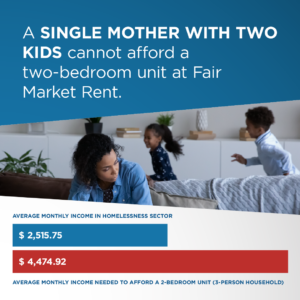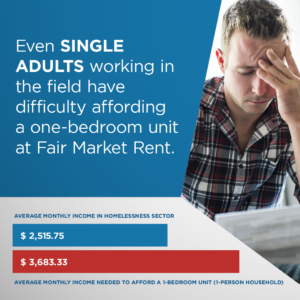Homeless service providers shouldn’t have to worry about becoming homeless themselves. Yet, with provider salaries that struggle to keep up with the cost of living, and organizations that struggle to maintain a burnt-out workforce, employee hardship is endemic in the homeless services field. To better understand challenges within the sector, the Alliance created a series of models to illustrate the limitations of average employee salaries, which considers how low wages and high turnover contribute to a system that’s already been pushed to the max.
Low Wages, High Turnover
A 2021 study by Dennis P. Culhane and Seongho An found that the average salary of all employees working in permanent and temporary housing programs was $30,189.1 This means that many in the homelessness sector earn far below the U.S. median household income of $70,784, and live in or close to poverty. Additional research suggests that low wages can be one of the key reasons for employees leaving their organizations (or the sector completely), rendering homelessness programs unable to house people effectively.
With low wages contributing to employee turnover, many organizations struggle to stay afloat. The National Council of Nonprofits (NCN) conducted a country-wide survey where it found that 26 percent of participating non-profits had 20-29 percent vacancy rates, with human-service jobs constituting most openings. Low wages were one of the biggest reasons for low retention and high turnover rates, along with the inability to find childcare. Within an industry that can demand long hours and emotionally and mentally taxing labor, employees (like their clients) must contend with skyrocketing rents that threaten their housing stability and general well-being.
Unfortunately, the pandemic may have worsened turnover rates by creating a more stressful environment. Continuums of Care (CoCs) surveyed by the Alliance in 2020 reported increased stress (96 percent), fear of contracting COVID-19 at work (91 percent), and exhaustion from longer hours and increased responsibilities (87 percent).
Additionally, high health risks among front line workers and low wages in the field have racial equity implications. Changes in pay will have a greater impact among those earning the least, typically frontline staff. The most recent Race to Lead Survey for the nation’s non-profits suggests people of color are more likely to be represented among frontline staff than to be senior managers.
Can You Live on a Provider’s Wage?
To illustrate employee hardship, the Alliance developed dashboards which break down estimated monthly expenses for a hypothetical family (led by “Erica”) and a hypothetical single adult (“Jacob”) based on Culhane’s and An’s annual salary estimates.1 Each household relies on a homeless sector employee as its sole income earner. Both adults are meant to represent the average employee in the field.
Both households were unable to afford a typical rental unit at fair market price. They were forced into cheaper alternatives such as smaller spaces (e.g., a family in a one-bedroom apartment), shared housing or doubled-up situations, or subpar units. Some of these situations can diminish one’s quality of life. Living paycheck to paycheck, many sector employees are likely forced to cut back on food, utilities, or other necessities to afford emergency needs like doctor visits.
The homelessness field must find ways to strengthen and stabilize its workforce. Otherwise, it cannot adequately serve everyone needing assistance or effectively end homelessness. Although other workforce challenges must be explored, incentivizing and removing barriers to livable wages is a worthy part of a conversation that needs to be further developed.
Resources
Download Graphics:



